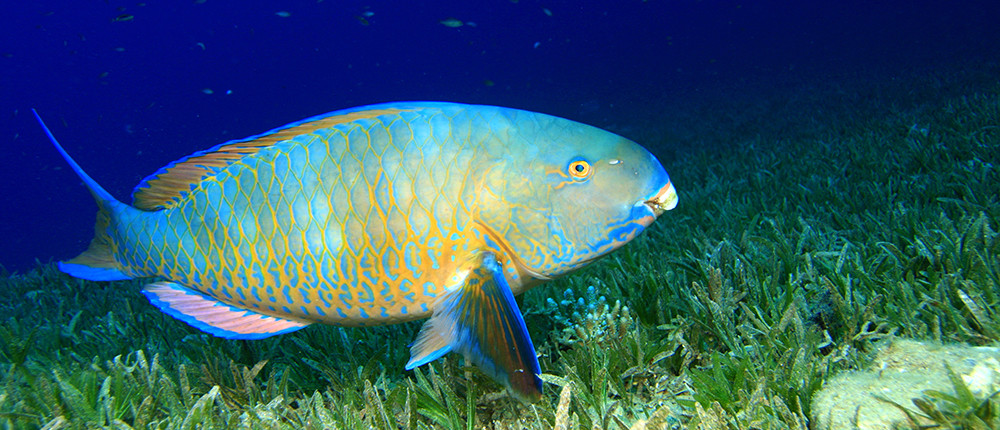Coming of Age
On the reefs of Wakatobi, age can bring dramatic changes
The waters around Wakatobi Resort are home to numerous species of fish that display intricate patterns and vivid hues. These brightly-colored residents of the reef provide fish watchers with hours of enjoyment as they seek to identify a particular species based on shape, coloration and patterning. To add to the identification challenge, many fish undergo changes in appearance as they mature. And we’re not just talking about human-style changes such as gaining a few pounds and growing facial hair or getting a tattoo. In the undersea world, stripes, spots and entire body colors will appear, fade or morph as these fish come of age. And as is the case with most things in nature, there’s a biological logic behind these transformations.

Often seen feeding on algae in the sheltered lagoons and shallow reefs around the resort, this juvenile Bicolor Parrotfish may go it alone or remain with a small group, and will grow up to become one of the more common inhabitants of the reef. It’s adult counterpart is featured in the image at the top of the page. Photo by Richard Smith, facebook/richardsmith
Change is good
When we swim along a reef at Wakatobi Resort, we see a lot of brightly-colored fish. But that’s because we are viewing things from human perspective. But fish see the world through different eyes, and process colors and shapes in different ways. Some of the hues and patterns a fish might display seem quite vivid to our eyes, but are actually well matched to the reef’s corals and water column when viewed by another fish. Rather than standing out, the colors serve as camouflage from both predators and potential prey.
By appearing to be an entirely different species, conflicts with territorial adults are reduced, allowing juveniles to gain access to resources within an adult’s territory.
There are several reasons why fish may change these color patterns as they mature. Juveniles that grow up in one environment may be perfectly camouflaged for their surroundings, but when they mature and move to a different environment, this relocation may require a corresponding shift in color and pattern. The second explanation for color change with age may be done to avoid conflict. During their larval stage, most reef fishes will undergo a broad ocean disbursement known as a plankatonic phase, which serves to spread the species, but leaves them on their own without any form of parental protection. As the juveniles begin to come into their own, there is often a need to avoid territorial conflict with adults of their species. This is less of a problem when the young fish grow up in a completely separate environment such as inshore shallows, but it could be a problem when all ages share the same habitat. By appearing to be an entirely different species, conflicts with territorial adults is reduced, allowing juveniles to gain access to resources within an adult’s territory.
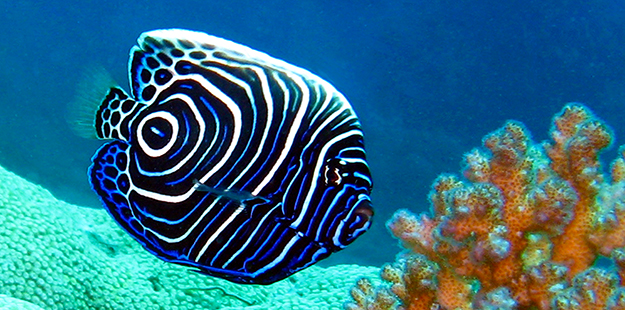
The juvenile emperor angelfish sports a psychedelic body coloration of swirls of dark blue with electric blue and white rings. It takes about 24 to 30 months for an emperor angelfish to acquire its adult coloring. Photo by Wakatobi Resort
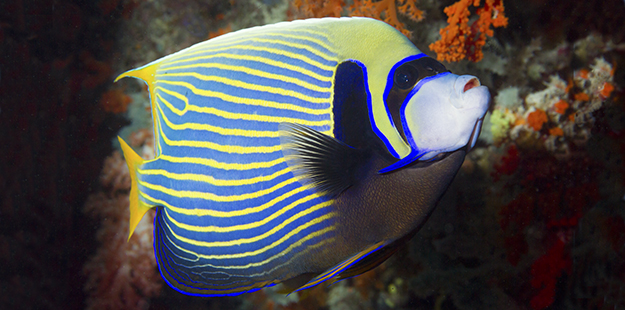
The intense blue and yellow stripes on the adult emperor angelfish are especially sensitive to our eyes and probably those of reef fishes too, but only at close proximity. Photo by Walt Stearns
A colorful youth
The juvenile emperor angelfish, which will range from the size of a dime to the diameter of your palm, looks like a child of the 60’s with a psychedelic body coloration of electric blue swirls and alternating pale blue lines. Because these color patterns are strikingly different from the adult’s, there was a time that even marine biologists thought the youngsters were a different species. Talk about having a colorful youth. As it matures, the emperor angelfish develops a color pattern more befitting of its regal name. Over a period of 24 to 30 months, a series of distinct blue and yellow stripes emerges and covers most of the fish’s body. To our eyes, these stripes stand out in vivid contrast, but at greater distances the stripes may help to disrupt the fish’s outline and camouflage it from ever-present predators. Should a predator attack, the dark band of color across the emperor’s nose helps to obscure the fish’s eyes and confuse the predator as to which end is which. This misdirection might enable the fish to escape with its life if the attacker guesses wrong on the potential prey’s direction of escape.
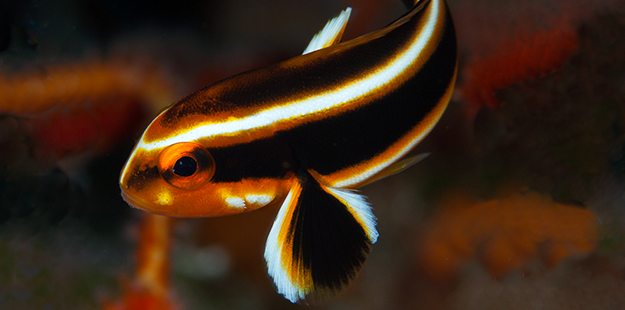
Juvenile striped sweetlips are not only colorful, they have an entertaining, erratic swimming style. Photo by Richard Smith, facebook/richardsmith
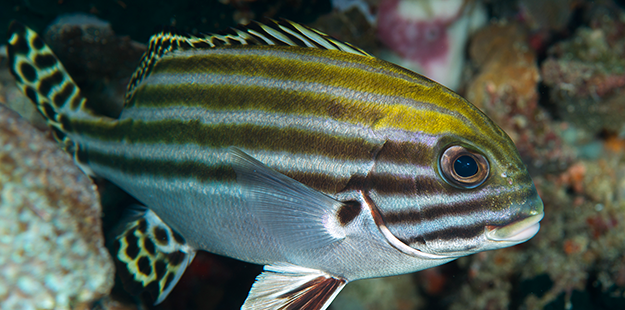
While the adult striped sweetlips’ coloration is more subdued, its stripes serve as a defense mechanism for moving in schools. Photo by Richard Smith, facebook/richardsmith
Earning its stripes
The colors and patterns of coral reef fishes are unexpectedly malleable. Some change color gradually with season or age, while others alter can their appearance almost instantaneously to blend into their surroundings, or to display their current emotional or motivational state. The striped sweetlips are among the slow changers, but they do undergo startling transformation from juvenile to adult. As a juvenile the sweetlips is not only a colorful gem, but also has the most entertaining erratic swimming style. As it matures, however, the flamboyance of youth gives way to a more subdued and predictable style that has practical applications. Stripes are a common color pattern among reef fishes, and this is particularly true among schooling species such as sweetlips. These fish form relatively loose schools that tend to hang together just off the reef. Their bold black and white stripes, while attractive to divers and photographers, also serve as a defensive mechanism. The stripes act to disrupt their wearer’s outline, making it difficult for predators to isolate and attack an individual fish within a moving school. Stripes running in the direction of movement may also make it harder for visual predators to judge an individual’s speed, giving the prey a slight edge when evading attack.
Gender identification
Members of the wrasse family undergo some of the most dramatic changes in coloration between their juvenile and adult stages. These change can plays an important role in social organization. Like many coral reef fishes, wrasses change sex through their lives and their coloration usually changes when this occurs, signaling their sexual state to other members of their species. One such example is the yellowtail coris. These small red-orange fish with bright white accents are common on reefs around Wakatobi, and when you spot one, you might think you’ve found Nemo.
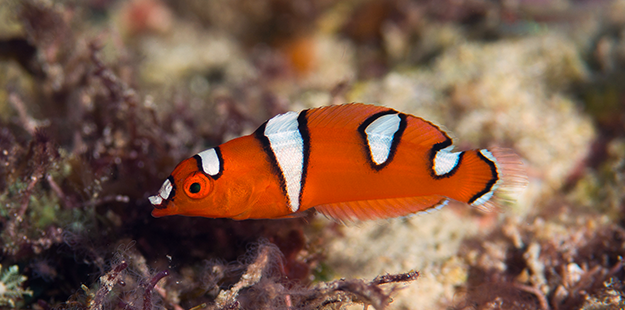
Because of its deep orange coloration with bright white accents the juvenile yellowtail coris is often mistaken for a clownfish. Photo by Richard Smith
But any resemblance to the famous clownfish is purely coincidental, and with age, the yellowtail coris will come into its own, transforming not once but twice as it matures. At a sub-adult stage the body coloration changes from red-orange to green, and the white bands are replaced by blue spots down the rear portion of the body and orange accents along both its dorsal and bottom anal fins, and across its face. When fully grown, the yellowtail coris can reach lengths of a foot or more, and may be found rooting up sea urchins for a meal. Fish close to this size are typically males, and sport their final transformation: a bright yellow to green mid-body bar that identifies the fish as a terminal male, meaning he’s a dominant spawner. Lesser males tend to have more drab colorations, and aren’t as likely to attract spawning partners. Proof, perhaps, of the benefits of being a sharp dresser.
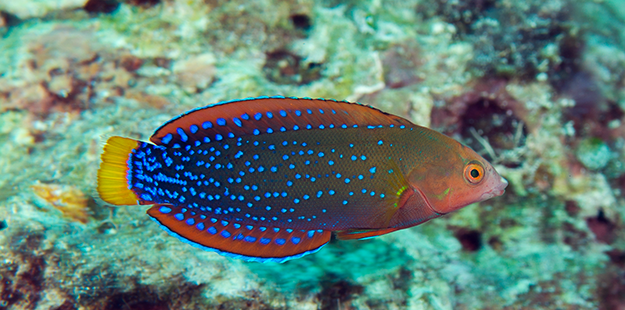
At a sub-adult stage, depicted here, the yellowtail coris has made a dramatic change to a greenish coloration. It’s white bands have been replaced by electric blue spots down the rear portion of the body and orange accents along both its dorsal and bottom anal fins, and across its face. Photo by Richard Smith, facebook/richardsmith


